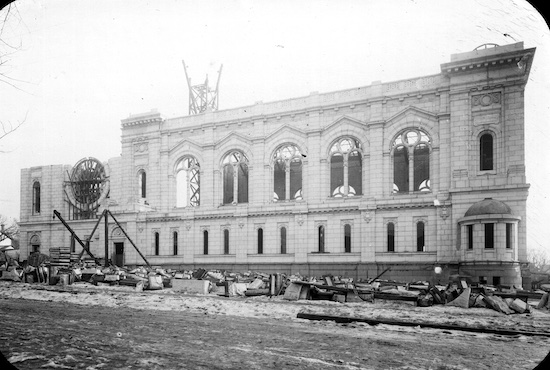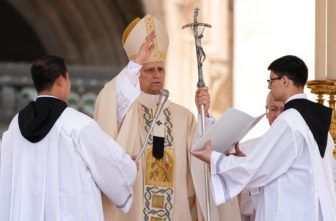
It was Sunday, May 31, 1908, when 150,000 people gathered in Minneapolis for something local reporters called the “most imposing spectacle of its kind ever seen in Minneapolis.”
Business owners along Nicollet and Hennepin avenues draped their storefronts with flags and buntings. American flags remained across town from the recent Memorial Day celebrations. Even the city courthouse chimes played patriotic airs on the hour between 1 p.m. and 5 p.m. Evidently, it was a patriotic celebration in addition to a Catholic one. All were gathered to celebrate the laying of the cornerstone of the Church of the Immaculate Conception Pro-Cathedral (better known today as the Basilica of St. Mary).
The core of the event was a massive parade that organized 30,000 men to walk a 21-block route ending at the building site. After the signal gun was fired at 2 p.m., the grand marshal led the parade, followed by 500 cadets from then-St. Thomas College in St. Paul, 17 bishops, and clergy and visitors from outside the Archdiocese of St. Paul and Minneapolis (including a priest from Alaska).
Next came the St. Paul and suburban parishes, marching eight across and nearly 10,000 strong. Organized by parish and fraternal societies, many flew both American flags and flags of their homelands. China, Japan, France, Poland, Bohemia, Scotland and Italy were all represented.
Then came those from the far corners of the archdiocese, many of whom had come into town by train. Finally, more than 15,000 men from Minneapolis and its suburbs were led by a float depicting Father Louis Hennepin discovering St. Anthony Falls in a canoe. Turning out in full force, Minneapolis parishes sent up to 600 men each, many in matching hats that might be black brimmed with gold braids or white with red, white and blue bands or even purple, depending on the group.
The only women in the parade were two girls from Our Lady of Perpetual Adoration dressed as Columbia and carrying the American flag. The papal delegate to the United States from Rome, Archbishop Diomede Falconio, brought up the rear of the parade, more than two hours after the march had begun.
After the crowd settled in around the building site, Archbishop Falconio, in his flowing purple robes, began consecrating the site. He began by sprinkling holy water on the site of the future main altar while seminarians chanted psalms in Latin. Then, he sprinkled the cornerstone with holy water and used an ordinary masonry trowel to trace three crosses on each side. The stone was lowered into place with masons leveling the cement before each visiting bishop tapped it with a mason’s hammer in turn. Finally, Archbishop Falconio sprinkled holy water on the foundation as he and the seminarians walked around the structure three times. With the formal blessing completed, speeches from Archbishop John Ireland, the governor, the mayor, James J. Hill and others followed, lauding the event.
In the coming months, construction continued, and it was six more years before the first Mass was celebrated in the new church. It was formally named the Pro-Cathedral of St. Mary in 1921, but the Vatican did not officially recognize it as the co-cathedral of the archdiocese until 1966, fulfilling Archbishop Ireland’s vision. In the meantime, Pope Pius XI established the church as a minor basilica in 1926, giving it the name most of us use today and making it the first basilica in the United States.
Luiken is a Catholic and historian with a doctorate from the University of Minnesota. She loves exploring and sharing the hidden histories that touch our lives every day.




